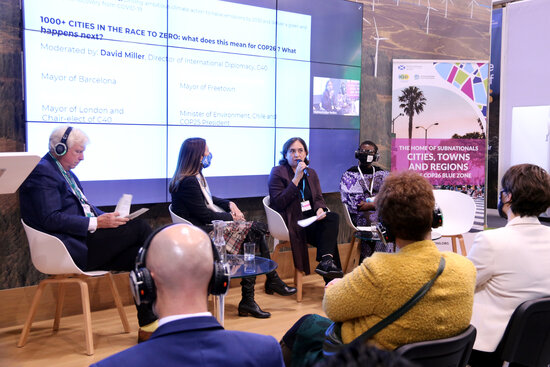Barcelona mayor, at COP26: just climate transition 'big opportunity to reduce inequality'
Data shows fall in pollution since introduction of Low Emissions Zone while UN report backs superblocks

Barcelona mayor Ada Colau, believes that, alongside reducing emissions, climate justice is the major challenge to be addressed during COP26, the United Nations climate conference being held in Glasgow.
Speaking as part of a panel organized by the C40 Cities group on Wednesday afternoon, Colau said a just climate transition represented a "big opportunity to reduce inequality around the world."
She told the panel that the first challenge, "that we all know about," is to reduce emissions "in a brave and decisive way." The C40 group's goal is to halve emissions by 2030.
The second fundamental challenge, according to the Barcelona mayor, is climate justice. "There has to be a transition, but we have to do it with social justice," she said.
Speaking alongside Chilean climate minister Carolina Schmidt, Freetown mayor Yvonne Aki-Sawyerr and London mayor Sadiq Khan, Colau laid out two examples of action taken by Barcelona City Council in an effort to tackle the climate crisis.
First, superblocks: areas where cars are excluded in favor of pedestrians, reducing pollution and making the city "better to live and work in." Second, a commitment to reducing energy poverty and prioritizing renewable energy. Colau said the city was trying to implement changes to the energy sector in a "creative" way, given that powers in this area lie primarily with the Spanish government.
UN report backs superblocks
Barcelona's superblocks and green corridors have been cited in a report from the UN Environment Program as an example of how big cities are dealing with global heating. The study cites 80 examples of cities around the world that have implemented measures to address rising temperatures, including Paris, Medellín, Toronto, Munich and New York.
In the case of Barcelona, the report says that superblocks aim to create "greener, fairer and safer public spaces" for residents, while "green axes" will reduce pollution and increase safety.
The UN study warns that global warming could be "catastrophic" in terms of public health, with experts warning that if the current increase in temperature is maintained, the world's population exposed to high temperatures - ie more than 35 degrees in summer - will increase by 800% by the middle of the century, affecting 1.6 billion people.
"There is an urgent need to move towards a more sustainable and equitable transition in terms of keeping our cities cool, and to ensure cooling where it is needed, without creating more warming in the urban environment," the report says.
Pollutants down 30% since introduction of Low Emissions Zone
Barcelona has succeeded in reducing pollutant emissions by almost 30% since introducing a Low Emissions Zone (known as the ZBE) in 2020, with average nitrogen dioxide levels in 2021 within European limits.
According to the latest data from the European Environment Agency, the average level of nitrogen dioxide this year is 22.87μg/m3, while in 2019 it was 32.25μg/m3 on average. The limit set by the European Union is 40 µg/m3.
Data for 2021 is even better than for 2020, when the average level of nitrogen dioxide was 24.35μg/m3. This includes the months of March, April and May where traffic levels plummeted due to the pandemic.
Barcelona City Council brought the Low Emission Zone into force in early 2020, but postponed issuing fines until September 2020 due to Covid-19.
Nitrogen dioxide emissions in the Catalan capital this October were 22.87μg/m3 on average, compared to 34.3μg/m3 in 2018 and 33.7μg/m3 in 2019. Some Barcelona districts including Eixample, Gràcia and Sant Gervasi exceeded the EU limit of 40µg/m3 in previous years. For example, in 2017 in the Eixample district, nitrogen dioxide levels reached almost 60 μg/m3, while in 2020 and 2021 it averaged 35µg/m3.
The European Environment Agency acknowledge that there has been a decline in the most polluted neighborhoods, which since 2020 have not exceeded the limits set. However, they believe that at the moment it is "difficult" to attribute the change to a single measure (ie the ZBE) because "the weather also has an influence" and there were "exceptional circumstances" during 2020.
The Low Emissions Zone restricts older, polluting vehicles from entering Barcelona on weekdays from 7am until 8pm, permitting them to drive along the orbital ring roads but not within the city.